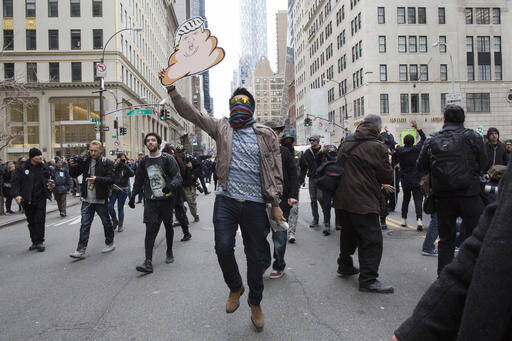“What’s up?” I asked one of the legion of police who seemed to have suddenly descended on the blocks where Broadway sweeps up into Columbus Circle with Lincoln Center to the West, Carnegie Hall to the East, the rolling spread of Central Park reaching out to the North. There weren’t quite enough police to protect President Obama when he is in town. Besides, he was in Cuba. Still this had to be something big.
And big it was. Sort of. A demonstration against Donald Trump was taking shape. They had rolled up from downtown and taken over the space surrounding the huge 1913 Maine Memorial with its hulking concrete statues of male nudes lolling at the feet of a goddess and a young boy waving from what represents the prow of a ship. Across from all this soars the International Trump Hotel and Tower.
The protesters were almost all young, college age or college plus, of different races and backgrounds; and they had climbed up onto the statues, or lined up as in a chorus, wielding home-made posters as weapons. There might have been 100 performers and many hundreds in the crowd. The single adult present, with no connection to the groups, was a medical doctor from Missouri who travels around the country joining protests for just causes. Today he danced out in front of the chorus wearing his Trump facemask with its Pinocchio nose, waving his arms to the cheers as if whipping up a local orchestra.
I consider myself as strongly anti-Trump, but some of the cheering turned me off. A young woman right beside me, in union with the mob, waved her sign and screamed again and again and again, “F— TRUMP!”
She was very short, so I had to bend down to talk with her. I asked whether she used that language all the time, or just on special occasions. Answer: All the time. With her family, at work, at social events. All the time. Would she raise her children to use that word? Yes. They would be “free” to say anything they wished. I suggested that the result would be a lack of respect for the cause she represented. She said she was just going along with the group.
Now I am told that today that the word is used widely. It has evolved to mean no more than “Gosh,” “Gee whiz” or “Darn-it.” I answer that English literature got along without it until very recently, and it still will not appear in respectable newspapers and no respected prominent person would use it in public discourse.
Half-way home I turned around, and hoping to meet the group's leadership, went back for one more try. I picked a young man with a beard in the front row brandishing the relevant sign. He was from Germany; he agreed that yes, they were lowering themselves to Trump’s level, sacrificing their credibility, and should have known better, then went back to yelling the word and waving high the poster.
On the way out I met two working men in their 30s who, as a caution, had been politely escorted out of the crowd by the police because they were supporting Trump. They had said to one another: If the parents of the protesters had visited the scene and heard the language they would have been horrified.
Later I returned to the scene to get a better understanding of the Maine Memorial, in memory of the “valiant seamen,” all named on the wall, who perished when the Maine sank in Havana Harbor in 1898. A plaque honors a Monsignor John P. Chidwick, chief of chaplains, who rescued many members of the crew and was one of the last men to leave the ship. The statues represent the Atlantic and Pacific Oceans, courage, fortitude, compassion and victory. Carved at the top: “The free men who died in the war with Spain so that others might be free.” Suddenly I discovered myself in a sacred place. If the protesters had known that, would they have altered their style?








